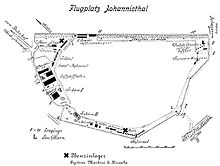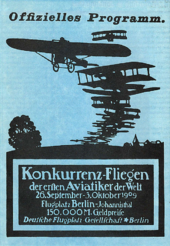Johannisthal Airport
| Johannisthal Airfield Johannisthal-Adlershof motor airfield |
|
|---|---|

|
|
| Characteristics | |
| Coordinates | |
| Height above MSL | 34 m (112 ft ) |
| Basic data | |
| opening | 1909 |
| closure | 1995 |
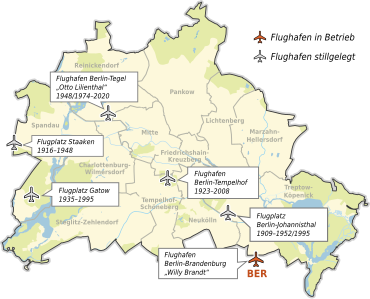
The Johannisthal airfield was opened in September 1909 as the first commercially run airfield and - after the August Euler airfield in Darmstadt - as the second motorized airfield in Germany. Because of its location between the Berlin suburbs of Johannisthal and Adlershof , it was still called the Johannisthal-Adlershof airfield at that time . After the use for civil passenger air traffic ended with the opening of the Tempelhof Central Airport in 1923 and it had not been used as a public airfield since 1952, it was officially closed in 1995 and then reused (commercial and residential development, Johannisthal / Adlershof landscape park ).
history
Development of the airfield

The term airfield goes back to Otto Lilienthal , who made his first attempts at gliding on an artificial hill, the Fliegeberg , in Lichterfelde . The German generals did not want to allow any halls for powered flight at the Tempelhof parade ground (later the airport ), as there were already halls for airships there. So you had to switch to a forest between Johannisthal and Adlershof. The construction of the field was initiated by the private German Airfield Society of the entrepreneur Arthur Müller and Major Georg von Tschudi , which later merged into the Flug- und Sportplatz GmbH Berlin-Johannisthal . Its managing director was von Tschudi in 1910, himself a flight pioneer, who had worked as managing director of the International Airship Exhibition in Frankfurt in 1909 . The airfield was put into operation with a competition flight on September 26, 1909.
Use before the First World War
The area covered around two square kilometers. On it was u. a. the building of the Imperial Aero Club , which in April 1911 was moved around 1000 meters on rails "American style". Between 1909 and 1911, two airship hangars were built for the Parseval airship and the zeppelin . The covered main grandstand alone had space for around 2,300 visitors, and another, open grandstand for a further 1,750. The area was surrounded by a three to four meter high fence, which was interrupted by eleven gates. Despite constant financial difficulties, the airfield became an international attraction. Between 1911 and 1913 alone, the flight times from the Johannisthal airfield increased tenfold from 20 to over 200 hours.
To finance the airfield one was dependent from the beginning on the income from the visitor business. A big problem was therefore the large number of spectators who climbed over the fence, endangering themselves and the planes, and paying no entrance fee. Von Tschudi: "At first I carried a Browning in my pocket, later a walking stick was sufficient as a threat." He particularly regretted that most of the spectators came to watch the - often fatal - accidents and many of them Took parts of the aircraft as “souvenirs” after crashes.
In 1910 a horse-drawn tram line was built from the Niederschöneweide-Johannisthal train station, about one kilometer away, to the main entrance. The operation only existed on flight days and was obviously not worthwhile, because only two months later it was shut down again. This was the last horse tram in what is now Berlin's urban area.
Aviation events
The first cross-country flight over Germany ended on the field on September 27, 1909 , when Hubert Latham , who was showing sightseeing flights with his Antoinette monoplane on Tempelhofer Feld , transferred his machine to "competitive flying". At the end of October 1909, the airfield was the venue for the Lanz-Preis der Lüfte competition founded by Karl Lanz in 1908 , which was won by Hans Grade from Magdeburg with his Grade II dragonfly . The first flight to Germany was started on June 11, 1911 from the Johannisthal airfield. Aviation pioneer Paul Engelhard had a fatal accident here on September 29, 1911 . Hundreds of thousands of spectators flocked to the spectacular flight event of the French star pilot Adolphe Pégoud in October 1913 at the Johannisthal airfield.
On October 17, 1913, 28 deaths occurred at the Johannisthal airfield, the worst for many years in airship travel, when the marine zeppelin LZ 18 caught fire and crashed.
The first continuous flight of more than 24 hours was carried out from July 10th to 11th 1914 by the Albatros works pilot Reinhold Böhm with an Albatros BI from the Johannisthal airfield.
Before the First World War, a colorful mix of aviation pioneers gathered in Johannisthal to test their sometimes very bizarre designs. Melli Beese , for example , became known after whom a primary school and a street near the airport are named today.
Companies and institutions
The following companies and institutions settled at the airfield by 1914:
- Wright Flying Machine - Aircraft Manufacture and Aviation School, Spring 1909
- Albatros-Werke - aircraft construction and flying school, December 1909
- Airship hangars - Parseval and Zeppelin airships are stationed , construction began in 1909
- Luftfahrtbetriebs-GmbH - passenger and advertising trips with Parseval airships, aircraft construction and flying school, 1910–1911
- Harlan Works - Aircraft Construction and Aviation School, 1910
- Rumpler-Luftfahrzeugbau GmbH - aircraft construction and flying school, October 1910
- Paul Schwandt - Aviation School, 1911
- E. Jeannin Flugzeugbau - aircraft construction and flying school, February 1912
- German Research Institute for Aviation - Aviation Research , April 1912
- Luftverkehrsgesellschaft (LVG) - aircraft construction and pilot school, 1912
- Fokker Aeroplanbau aircraft construction, 1912
- Ago Airline - Aircraft Construction and Aviation School, 1912
- Aircraft company - aircraft construction and flying school, 1913
- General Aviation School - Aviation School
- Bruno Hanuschke - Aviation School
- Johannisthaler Filmgesellschaft AG
- Aviation School Berlin-Adlershof of the German Air Fleet Association - classrooms, assembly and meteorological observations
First World War
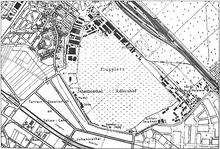

Industrial aircraft manufacturing
With the outbreak of the First World War in 1914, the authority of the airfield company was revoked and the airfield was used purely for military purposes. The industrial production of reconnaissance and combat aircraft in the various factories at the airfield advanced rapidly. To transport the large numbers of finished machines, a siding was laid up to the Albatros works by 1916, which was then expanded as a circular line around the airfield in 1917/1918.
Over 25 percent of the around 48,000 aircraft produced in Germany during World War I were supplied by manufacturers at the airport:
| Manufacturer | number of pieces |
|---|---|
| AGO / AEG | 620 |
| Albatross | 6242 |
| Idol | 16 |
| Aircraft Company (LFG) | 800 |
| Air transport company (LVG) | 2400 |
| Rumpler | 2806 |
| Sablatnig | 30th |
| total | 12914 |
Comparison flies
In addition to the factory airfield function of the airfield was used during the war as an aircraft test site of the Air Force . In order to obtain high-performance fighter aircraft (" D-aircraft ") from the manufacturers, the Army Command arranged three D-aircraft competitions at the airfield in 1918 (in the literature also often referred to as comparison flights in Berlin-Adlershof ), in which the best pilots the front tested the new models. The comparison flights took place in January / February, June / July and October 1918. From the comparison flight from January 28th to February 3rd, 1918, the Fokker D.VII, feared by the enemy, emerged as the winner.
Weimar Republic and National Socialism
Immediately after the First World War, the history of civil airmail in Germany began in Berlin-Johannisthal on February 5, 1919 . From that day on, planes of the Deutsche Luft-Reederei took off there twice a day to transport mail - especially newspapers - to Weimar , the meeting place of the constituent national assembly . In the first few months of its existence, only the members of the National Assembly were allowed to use this airmail connection.
When Tempelhof Airport opened in 1923, the civil significance of the airfield fell sharply. During the National Socialist era , Johannisthal was used as a test field for the secret armament of the Wehrmacht ; u. a. from the German Aviation Research Institute (DVL) based there.
Companies at this time:
- Prussian Motor Works (around 1929)
post war period
Operated after the war him for a year Soviet air forces of the GSSD , until their relocation to the airport Berlin-Schönefeld . The more Schönefeld was expanded, the less use there was for the old airfield. After being orphaned for a long time, it was officially closed in 1995 after a flight event. At this event, the German astronaut Reinhard Furrer had a fatal accident on September 9, 1995.
Companies at this time:
- VEB Motorenwerk Johannisthal (around 1960)
- VEB Kühlautomat Berlin- Johannisthal (1950–1991)
- Kühlautomat Berlin GmbH (1991–1996)
- GEA (1996-2004)
- Factory halls unused (since 2004)
Conversion
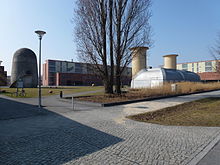

Today, among other things, the Aerodynamic Park is located on the southern part of the site as part of the campus of the Humboldt University in Berlin. The name of the square points to the special character and the historical and architectural significance of the concise and dominant architectural monuments of the former German Research Institute for Aviation e. V. out.
The green biotope that has now emerged on the area of the former runway has been integrated into a park landscape that was created after a competition since the late 1990s. The approximately 65 hectare area of the Johannisthal / Adlershof landscape park is designated as a landscape protection area (LSG 48) and in the central area as a nature reserve (NSG 35), each under the name “Former Johannisthal Airfield”.
literature
- Günter Schmitt: When the vintage cars flew - the history of the Johannisthal airfield . Transpress, Berlin 1980, ISBN 3-344-00129-9 .
- Günter Schmitt: When the powered flight began in Johannisthal ... In: Council of the city district Berlin-Treptow (Hrsg.): Treptower Historische Hefte . tape 1 . Berlin 1979.
- Heinz Nowarra: Richthofen's three-decker and Fokker D VII . In: arsenal of weapons . tape 67 . Podzun-Pallas, Friedberg 1981, ISBN 3-7909-0146-6 .
Web links
- Johannisthal airfield and cradle of German aviation . Gert Steidle, 1999, Luftfahrtgeschichte.com, Ed. Gert Steidle, Neckartenzlingen.
- Senate Department for Urban Development Berlin: NSG former airfield Johannisthal (with download: flyer, display boards in the park).
- 100 years of Johannisthal Airport.
- For 100 years the motto in Berlin has been “Up, up and away” . In: Der Tagesspiegel , September 13, 2009.
- Friends of the Landscape Park Johannisthal / Adlershof e. V.
- Ernst R. Pietsch: What an overwhelming sight is presented to our astonished eyes! . Excerpt from the book The Pietsch couple on a pleasure trip on the Baltic and North Sea 1908/1912 , pp. 171–181. Ed .: Stefan Wolter, ISBN 978-3-86634-460-0 .
Individual evidence
- ↑ a b Adlershof Stories Volume 1 ( Memento from August 24, 2018 in the Internet Archive ) (PDF; 1.2 MB)
- ↑ Ursula Eckstein: August Euler Airfield Darmstadt . Justus von Liebig Verlag Darmstadt 2008, p. 28
- ^ Cover page of the program for competitive flying from September 26, 1909
- ↑ Von Tschudi, p. 112
- ↑ Tram from the Johannisthal airfield at www.berliner-bahnen.de
- ↑ When the oldtimers flew , p. 20ff
- ↑ Adlershof Stories Volume 1 ( Memento from August 24, 2018 in the Internet Archive ) (PDF; 1.2 MB) P. 16
- ↑ Peter Philipp-Schmitt: A dream of the air explodes . In: FAZ , October 16, 2013, accessed on August 23, 2018.
- ^ Johannisthal letter . From our Johannisthal correspondent. In: Carl Oskar Ursinus (Ed.): Flugsport . No. 15 . Verlag für Flugsport, Frankfurt am Main July 22, 1914, p. 631 ( Aviation in the Luftfahrt-bibliothek.de [accessed on August 19, 2018]).
- ↑ When the classic cars flew , p. 86ff
- ↑ Albert Rupp, Willy Rosenstein: The Aviation School. A textbook for the flight student , Volckmann, Berlin 1913, p. 34 ff
- ↑ When the classic cars flew , p. 173
- ↑ When the classic cars flew , p. 184
- ↑ When the classic cars flew , p. 183
- ↑ Richthofens Dreidecker and Fokker D VII , p. 20
- ↑ Sources: Chronicle Kühlautomat, Chronik Johannisthal, Museum Johannisthal
